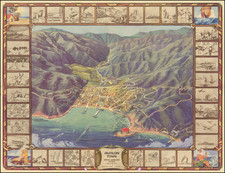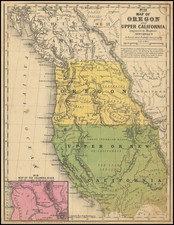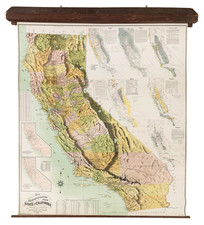Attractive brochure produced by the state printing office advertising the Central Valley Project, California's massive irrigation project which moved water from Shasta Dam and Friant Dam to the Central Valley. When started, this irrigation project was the world's largest and formed an important part of the New Deal agenda ("the largest conservation project in the history of man").
The map includes numerous drawings of the Shasta Dam and Friant Dam, then under construction. To emphasize the height of these projects, they are compared to the Bay Bridge and the Sun Tower at UC Berkeley, showing a San Francisco focus. Numerous notes emphasize the power generation and irrigation potentials of the project. Interestingly, it advertises the project as a "$ 228,000,000 defense against flood and drought."
This brochure also includes a birdseye view of California as seen from the Pacific, based on one created for their 1938 brochure. Here updated, it shows major waterways in the state, focusing on the dams under construction.
The Central Valley Project
In 1873, Barton S. Alexander completed a report for the U.S. Army Corps of Engineers that was the first attempt at creating a Central Valley Project as a means of delivering water from Northern California to the Central Valley. In 1904, the Bureau of Reclamation (then the Reclamation Service) first became interested in creating such a water project, but did not get further involved until a series of droughts and related disasters occurred in the early 1920s.
The State of California passed the Central Valley Project Act in 1933, which authorized Reclamation to sell revenue bonds in order to raise about $170 million for the project. Unfortunately, because of insufficient money in the state's treasury and the coincidence with the Great Depression, California turned to the national government for funding to build the project. This resulted in several transfers of the project between California and the federal government, and between Reclamation and the Army Corps of Engineers.
The first dams and canals of the project started going up in the late 1930s, and the last facilities were completed in the early 1970s.











![[Mexico and Central America with Baja California inset, from Generalkarte von Nord America samt den Westindischen Inseln Versasst von Herrn. Pownall . . . MDCCLXXXVIII]](https://storage.googleapis.com/raremaps/img/small/95064.jpg)



![[WWII War Bonds] As](https://storage.googleapis.com/raremaps/img/small/63461.jpg)
